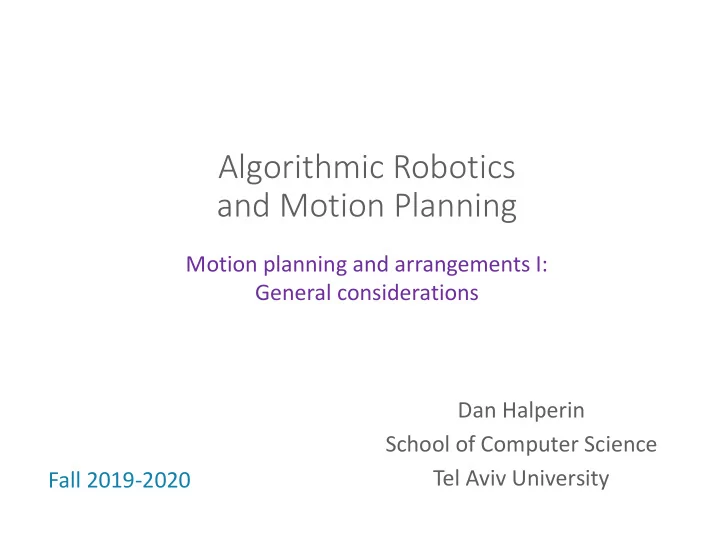

Algorithmic Robotics and Motion Planning Motion planning and arrangements I: General considerations Dan Halperin School of Computer Science Tel Aviv University Fall 2019-2020
Overview • Arrangements, reminder • Arrangements and configuration spaces • Examples • General exact algorithms for motion planning
Reminder What are arrangements? Example: an arrangement of lines vertex edge face 3
What are arrangements, cont ’ d • an arrangement of a set S of geometric objects is the subdivision of space where the objects reside induced by S • possibly non-linear objects (parabolas), bounded objects (segments, circles), higher dimensional (planes, simplices) • numerous applications in robotics, molecular biology, vision, graphics, CAD/CAM, statistics, GIS • have been studied for decades, originally mostly combinatorics nowadays mainly studied in combinatorial and computational geometry 4
Arrangements of lines: Combinatorics the complexity of an arrangement is the overall number of cells of all dimensions comprising the arrangement for planar arrangements we count: vertices, edges , and faces the general position assumption: two lines meet in a single point, three lines have no point in common 5
In an arrangements of 𝑜 lines number of vertices: 𝑜 ( 𝑜 − 1)/2 number of edges: 𝑜 2 number of faces: using Euler ’ s formula | 𝑊 | − | 𝐹 |+| 𝐺 |= 2 we get 𝑜 2 + 𝑜 2 /2 + 1 6
Basic theorem of arrangement complexity the maximum combinatorial complexity of an arrangement of 𝑜 well-behaved curves in the plane is 𝑃 ( 𝑜 2 ); there are such arrangements whose complexity is Ω ( 𝑜 2 ) more generally the maximum combinatorial complexity of an arrangement of 𝑜 well-behaved (hyper)surfaces in ℝ 𝑒 for a fixed 𝑒 is 𝑃 ( 𝑜 𝑒 ); there are such arrangements whose complexity is Ω ( 𝑜 𝑒 ) 7
Configuration spaces • arrangements ( 𝒯 ) are used for exact discretization of continuous problems • a point 𝘲 in configuration space 𝒟 has a property П ( 𝘲 ) • if a neighborhood 𝑉 of 𝘲 is not intersected by an object in 𝒯 , the same property П ( 𝑟 ) holds for every point 𝑟 ∊ 𝑉 (the same holds when we restrict the configuration space to an object in 𝒯 ) • the objects in 𝒯 are critical • the property is invariant in each cell of the arrangement 8
Configuration space for translational motion planning the rod is translating in the room • the reference point: the lower end-point of the rod • the configuration space is 2 dimensional 9
Configuration space obstacles the robot has shrunk to a point ⇒ the obstacles are accordingly expanded 10
Critical curves in configuration space the locus of semi-free placements 11
Making the connection: The arrangement of critical curves in configuration space 12
Solving a motion-planning problem a general framework • what are the critical curves • how complex is the arrangement of the critical curves • constructing the arrangement and filtering out the forbidden cells • what is the complexity of the free space • can we compute the free space efficiently • do we need to compute the entire free space? 13
Example: a disc moving among discs • the critical curves are circles • how complex is the arrangement of the circles? • what is the complexity of the free space? • can we compute the free space efficiently? • do we need to compute the entire free space? does it matter? ? 14
Example: an L-shaped robot moving among points • what are the critical curves? • how complex is the arrangement of the critical curves? • what is the complexity of the free space? • how to compute the free space efficiently? • next, we let the L rotate as well • what are the critical surfaces? • how complex is the arrangement of the critical surfaces? • what is the complexity of the free space? 15
Complete solutions, I the Piano Movers series [Schwartz-Sharir 83], cell decomposition: a doubly-exponential solution, 𝑃 (( 𝑜𝑒 ) 3^ 𝑙 ) expected time assuming the robot complexity is constant, 𝑙 is the number of degrees of freedom, 𝑜 is the complexity of the obstacles and 𝑒 is the algebraic complexity of the problem 16
Complete solutions, II roadmap [Canny 87]: a singly exponential solution, 𝑜 𝑙 (log 𝑜 ) 𝑒 𝑃 ( 𝑙 ^2) expected time see also [Basu-Pollack-Roy 06] 17
Bibliography References to all the results mentioned in this presentation and more can be found in the following two chapters of the: Handbook of Discrete and Computational Geometry — Third Edition — edited by Jacob E. Goodman, Joseph O'Rourke, and Csaba D. Tóth CRC Press LLC, Boca Raton, FL, 2018 • Chapter 28, Arrangements, Halperin and Sharir • Chapter 50, Algorithmic Motion Planning, Halperin-Slazman- Sharir
THE END
Recommend
More recommend